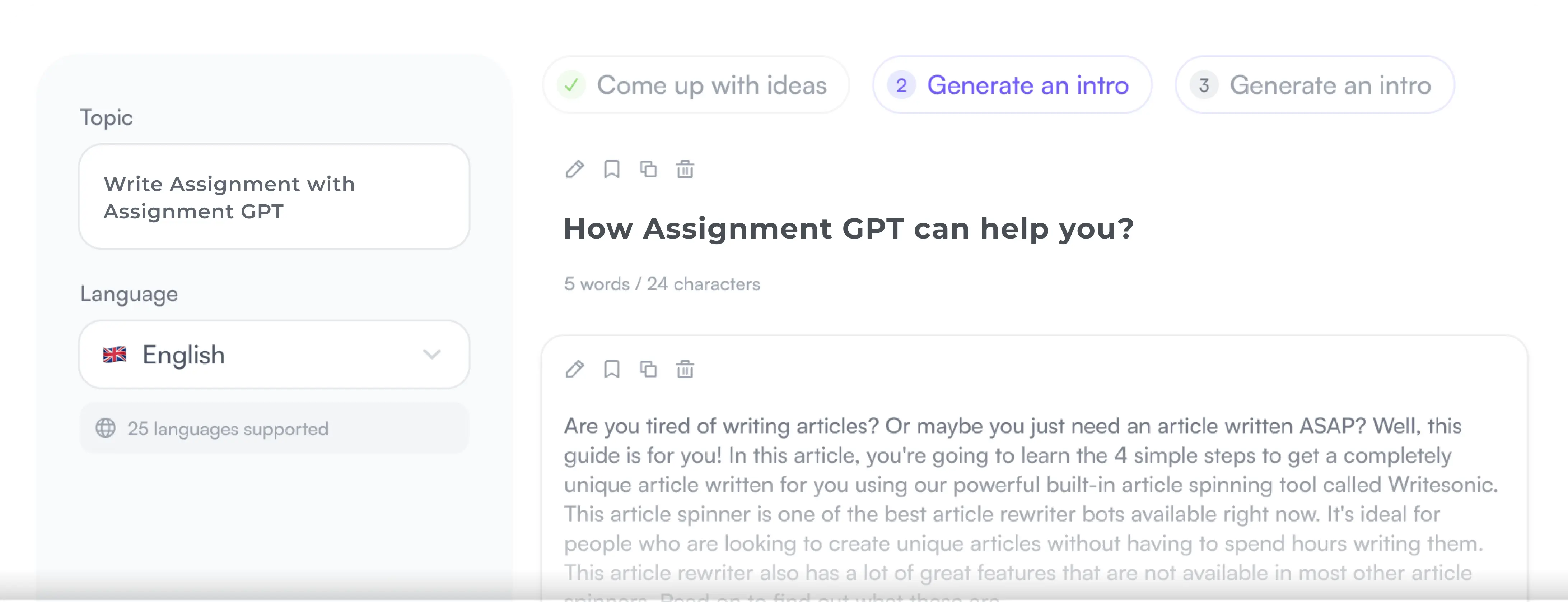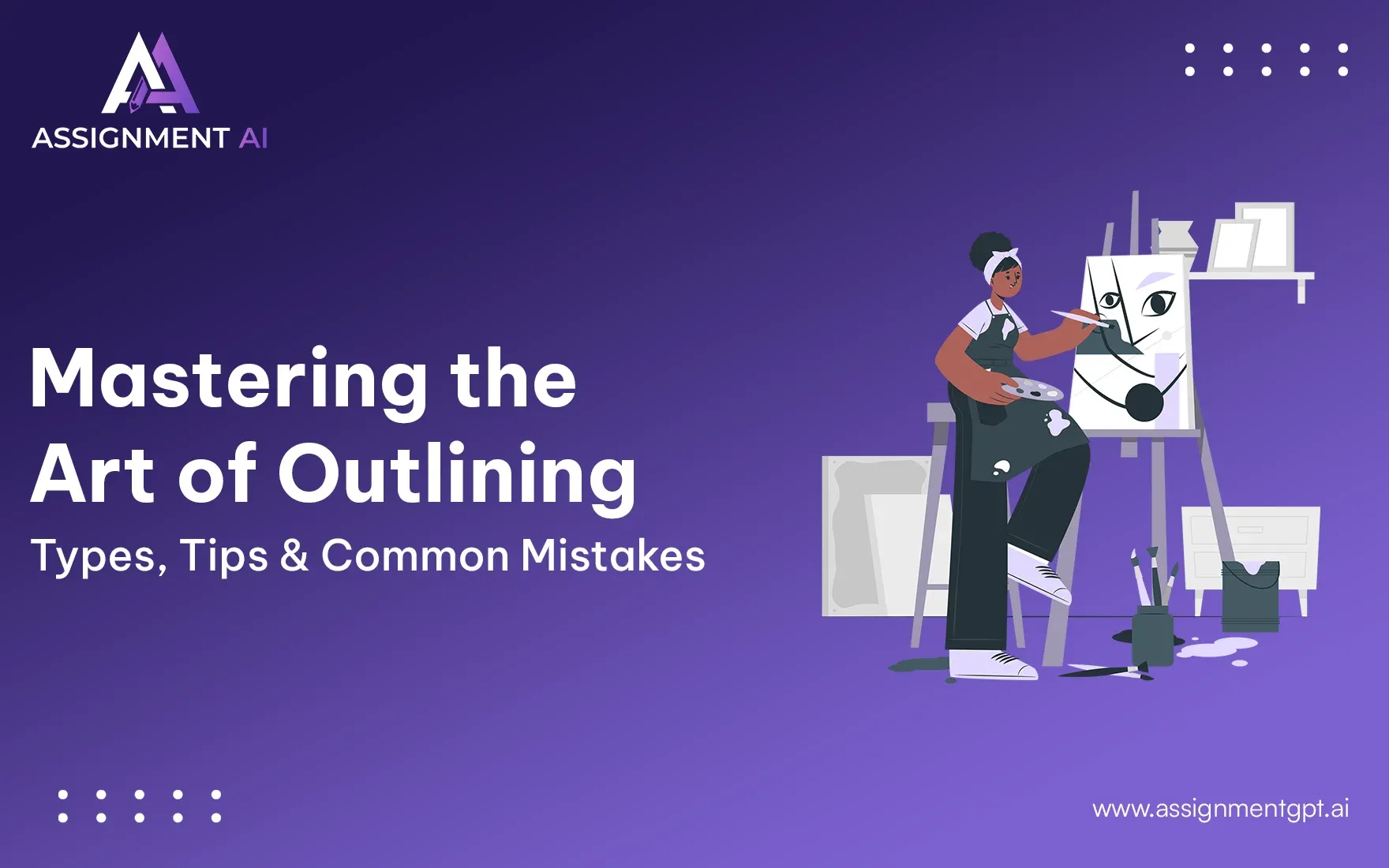AssignmentGPT Blogs
Just imagine that you have got a big writing project, which you have to write from scratch uniquely and you are looking at the blank paper and thinking that how should I finally explain my thoughts on the paper, so that my thoughts seem engaging and compelling in a way that the audience and my clients get satisfied.
You are not the only one who thinks like this. I have also experienced this many times that whenever I have to write on very important topics, lots of ideas come to my mind, but I do not know what structure I should use to write my thoughts on paper.
I also faced this problem many times, but with experience, I learned about a very important terminology called "Outlining". This term is not only valid for text content, but it also plays a very important role in drawing and software projects, because before converting your idea into a final structure, it is important to make an outline, which you use to give a shape to your final project. So, if you also want to become a professional writer or an author, then it is very important for you to learn about outlining. So today in this article, we will try to know in detail how we do outlining and what its pros and cons are.
Quick Summary
It is very important to do outlining before starting any detailed article or project because, without outlining, you will often not be able to create a context and an engaging project. That is why outlining is done, in which important points and structure are professionally outlined so that the content can be written to the point. The overall outline is a structured plan that organises your ideas before you start writing.
So in today's detailed article, we will learn formal and informal outlines, about six specific types (decimal, alphanumeric, topic, reverse, working, and sentence), and we will share tips to make your outlines clear, flexible, and effective so that your content will look professional.
What is an Outline?
So let's first clear the basics. An outline is like a game plan for your writing or project, It's a way to organise your thoughts, structure your ideas, and make sure your final piece flows logically from start to finish. Overall, it is a kind of map which it tells you at what speed and which path you have to follow to reach your destination, and without this "Outline" map, you can never reach your destination. Because outlining gives you the facility to write in a point-by-point or context way, which connects the complete content together, without an outline, your content will seem disconnected and will never be reader-friendly.
Outlining according to the document or topic gives you a foundation of content, it helps you spot gaps in your logic, avoid tangents, and keep your message clear. And this is equally helpful and important not only in professional writing but also in blog posts, novels, speeches, etc.
Reasons why outlines are important?
Clarity: Outlining helps you write only what you really want to say.
Organisation: With the help of outlining, you can organise your ideas in the right sequence. Without outlining, you can place any idea in any heading, which will never make the writing feel engaging.
Efficiency: They save you time by catching weak spots before you write 2,000 words of nonsense or non-engaging content.
Confidence: With a solid outline, you’re not staring at a blank page, wondering where to start. Outlining gives you a complete path, which you only have to follow.
What is a Formal Outline?
You can consider formal outlines a cousin of the "outlining" family. It is the beginning step of outlining, where you first write your raw ideas on paper. Formal outlines use a strict system like alphanumeric (I, A, 1, a) or decimal (1.0, 1.1) to show hierarchy and relationships between ideas. Following this process helps you write content in a flow to a large extent, where every line and sentence feels connected to each other. Outlining plays an important role in projects that are complex or where you need to write content very precisely, such as research papers and technical reports.
Imagine you're writing a 20-page research paper on climate change. A formal outline helps you lay out your thesis, major arguments, and supporting evidence in a clear, logical order. This will give you a kind of blueprint in which you can design your content building in a sequence so that your content becomes strong and engaging. In such content where precision, structure and clarity are very important, you have to use formal outlining so that you can maintain the quality of your content.
Reasons why Formal outlines are important?
Structured Hierarchy: As we already know, in formal outlining, we have to use numbers, letters, or decimals to show main points, subpoints, and details, and this process makes the quality of content quite professional and full of clarity.
Detail-Oriented: Formal outlining often includes full sentences or specific evidence (like quotes or stats).
Professional Vibe: Formal outlining is ideal for projects where you need to impress with organisation and precision. Formal outlining facilitates you to show clarity in your content.
What is an Informal Outline?
Informal Outline follows a flexible or simple process, in which you create an outline using your ideas, thoughts, and references. Informal Outline is also called early-stage outlining. In comparison to a Formal Outline, an Informal Outline follows a less structured process.
Overall, Informal outlining is flexible, free-form, and perfect for when you’re just getting your ideas out there. Informal outline writing is best compared to creative writing, less structured projects, blog posts or personal essays. The document notes that informal outlines are ideal for early-stage planning or less rigid formats. The informal outline gives you flexibility without following a strict structure.
Different Types of Outlines in Writing
We have learned the basics of Outlining, now let's get a little more detailed and in-depth about outlining. Now we will learn about different types of outlines and where you can use these different outlines. All types of outlining have their own different uses and purposes, you have to choose the right outlining type according to your project.
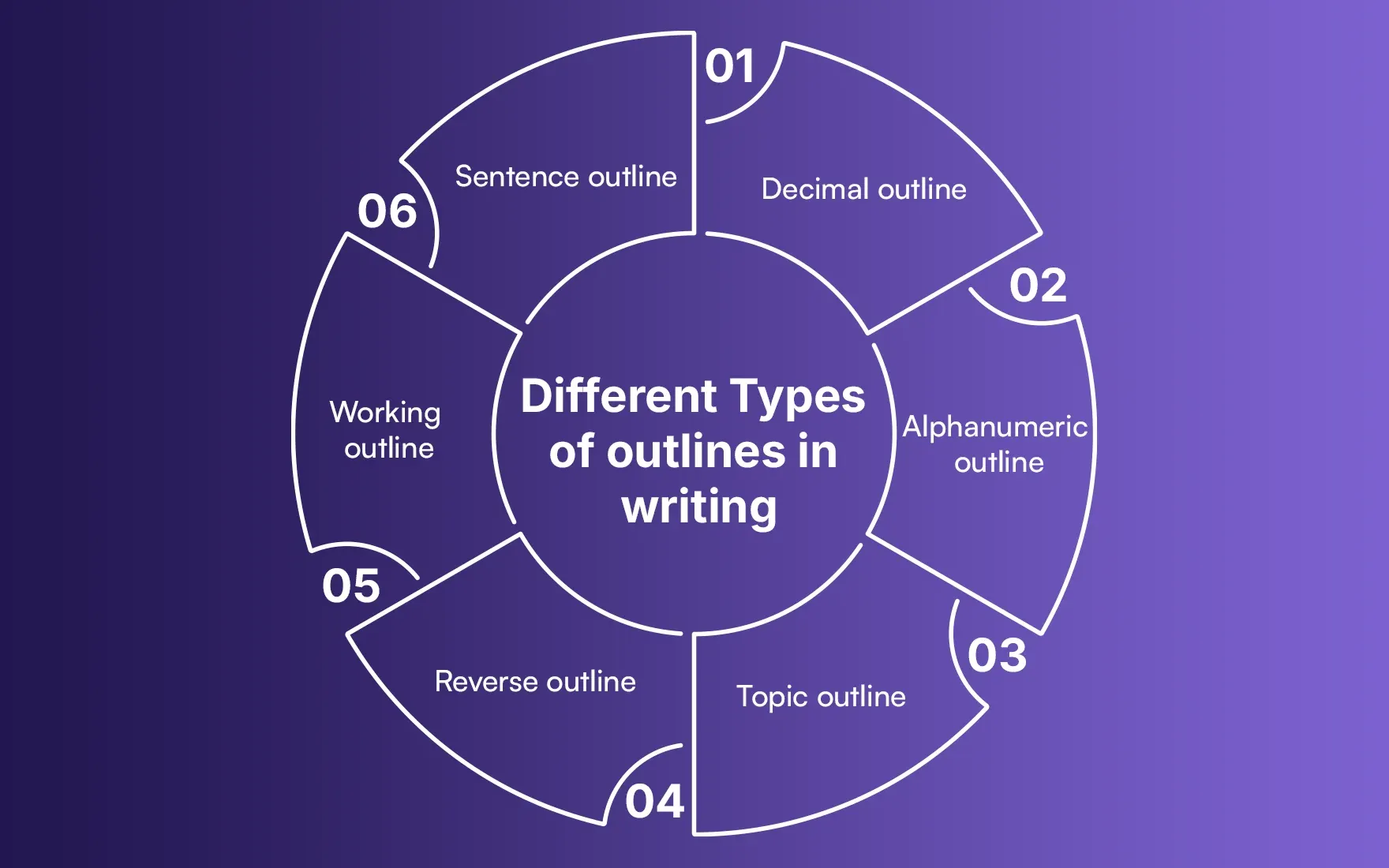
1. Decimal Outline
What it’s used for: The decimal outline is an organised, hierarchical system that uses numbers (like 1.0, 1.1, 1.1.1) to show the relationship between ideas. It’s perfect for technical documents, research papers, or anything that needs a clear, logical structure. Overall, I also use it for my complex projects or articles, a decimal outline gives you a spreadsheet-like feel in which you know the next idea according to what exactly you have to write.
Decimal outline example: Let’s say you’re writing a report on workplace productivity. Here's what a decimal outline will look like:
1.0 Introduction 1.1 Importance of productivity 1.2 Purpose of the report 2.0 Factors Affecting Productivity 2.1 Work environment 2.1.1 Office layout 2.1.2 Noise levels 2.2 Employee well-being 2.2.1 Mental health support 2.2.2 Work-life balance 3.0 Strategies to Improve Productivity 3.1 Technology integration 3.2 Training programs 4.0 Conclusion 4.1 Summary of findings 4.2 Recommendations
This format is great because it shows exactly how each point connects to the bigger picture. Overall, it’s like a family tree for your ideas, with main points branching into subpoints and details.
2. Alphanumeric Outline
What it’s used for: The alphanumeric outline is the classic outline format you probably learned in school. It uses Roman numerals (I, II), capital letters (A, B), numbers (1, 2), and lowercase letters (a, b) to organise ideas. It’s versatile and works well for essays, reports, or presentations where you need a clear hierarchy. This outlining format is specially used for English-based academic tasks like essays or papers.
Alphanumeric outline example: Imagine you're writing an essay about the benefits of meditation. Here's an alphanumeric outline:
I.Introduction A. Definition of meditation B. Thesis: Meditation improves mental and physical health. II. Mental Health Benefits A.Stress reduction 1. Scientific studies 2. Personal anecdotes B.Improved focus III. Physical Health Benefits A. Lower blood pressure B. Better sleep quality IV. How to Start Meditating A. Simple techniques B. Recommended apps V. Conclusion A. Recap of benefits B. Encouragement to try meditation
This format is clean, professional, and easy to follow. This is why it is given a lot of preference in European academic writing. And if you read any English novel, you will also notice this outlining structure.
3. Topic Outline
What it’s used for: A topic outline is so similar to a minimalist dream, in which you use your short ideas to write an outline on paper. It uses short phrases or single words to capture the main ideas and subpoints, without going into full sentences. It’s great for planning less formal projects like blog posts or creative writing.
Topic outline example: Let's say you're planning a short story about a time traveller. A topic outline will look like this:
Intro: Meet the protagonist Setting: 25th-century city Conflict Time machine malfunction Stuck in the past resolution Finding a way home Lessons learned Conclusion: New perspective on life
Topic outline is also used to keep the content short, sweet, and to the point. This type of outline is perfect when you’re just writing your ideas and thoughts, and don't write detailed planning.
Also read this article : AI in Education is Transforming the Industry
4. Reverse Outline
What it’s used for: A reverse outline is a bit of a wildcard. Instead of creating it before you write, you make it (after) you've got a rough draft. It's like reverse-engineering your own work to check its structure and flow. This is super helpful for revising messy drafts or making sure your ideas connect logically.
Reverse outline example: Suppose you’ve written a draft of an article about sustainable living. You read through it and create this reverse outline:
I Intro: Why sustainability matters II. Current environmental challenges A.Plastic waste B.Carbon emissions III. Sustainable practices A. Reducing waste B. Using renewable energy IV. Challenges of adopting sustainability V. Conclusion: Call to action
By using a reverse outline, you can spot gaps, like missing evidence or sections that don't flow. This way, you can check the health of your writing.
5. Working Outline
What it’s used for: A working outline is a rough, evolving plan you create as you fantastically plan and research. This outlining is flexible because your outline also changes as your idea develops.
Working outline example: Let’s say you’re planning a presentation on artificial intelligence. Your working outline will start like this:
Intro: What is AI? History of AI Early developments Modern advancements Applications Healthcare Business Ethical concerns Wrap-up: Future of AI
As you research, you might add more details or rearrange sections. It’s a living document, perfect for projects where you’re still figuring things out. And in teamwork, mostly the working outline is used.
6. Sentence Outline
What it’s used for: A sentence outline is like a formal outline, but with full sentences for each point. It's detailed and specific, making it ideal for complex projects where you want to completely write down your ideas before writing. It's like writing a small portion of your detailed content.
Sentence outline example: For a research paper on renewable energy, a sentence outline will look like this:
Renewable energy is critical for sustainable development. A. Solar power is a leading renewable energy source. 1. Solar panels convert sunlight into electricity efficiently. 2. Costs of solar energy have decreased significantly since 2010. B. Wind energy complements solar in many regions. II. Challenges of transitioning to renewables include infrastructure costs. III. Government policies can accelerate renewable adoption. IV. Investing in renewables ensures long-term environmental benefits.
This format forces you to think through your ideas clearly, making the actual writing process smoother. The sentence outline is used a lot in team ideas presentation, in which you try to show most of the portion of your project in your outline, so that the team members have clarity.
Common Mistakes to Avoid in Writing an Outline
We have learned about outlining in detail, but let us learn about the common mistakes of outlining writing. Because knowledge of anything is gained through your mistakes. Let us learn about 3 common and big outline writing mistakes.

1. Make it Too Rigid
An outline is supposed to be your guide, not a fixed script. If you make it too rigid, you’re boxing yourself in, and that’s a creativity killer. Imagine you’re writing a novel, and your outline says the protagonist must meet their love interest in Chapter 3. But as you write, you realise the story flows better if they meet in Chapter 5. A rigid outline might make you stick to the original plan, even if it hurts the story.
How to avoid it: You always keep your outline flexible. Think of it as a rough draft, not a contract. If a new idea pops up while you're writing, tweak the outline to accommodate it. The document emphasises that outlines should evolve as your understanding of the topic grows, so don’t be afraid to make changes. Always keep your outline flexible, so that you can make your content outline as simple and engaging as possible.
2. Misalign it with Your Purpose
Your outline needs to match your writing’s goal. If you're writing a persuasive essay but your outline is full of random facts with no clear argument, your final piece will feel like a jumbled mess. The document warns that misaligning your outline with your purpose can make your writing scattered or unclear.
How to avoid it: Start by defining your central idea (more on this later). Make sure every section of your outline supports that goal. For example, if your purpose is to convince readers to recycle, every point in your outline should tie back to that argument, whether it’s stats on waste reduction or emotional appeals about saving the planet.
3. Skip the Outline Entirely
Sometimes we start outlining anything in excitement, in which we start writing whatever idea comes to our mind without any planning, due to which the clarity of the outline is missing, which makes it quite messy and disorganised. And you miss the important points and structure of the content.
How to avoid it: Even if you are very excited about outlining, you still have to wait for at least 10 minutes so that you can start with informal outlining. By waiting for a while and outlining, your mind gets ideas and time to do outlining in an organised way.
Tips for Effectively Writing an Outline
We have learnt what you should not do while outlining, but let us know how you can make your writing outline more effective and engaging.
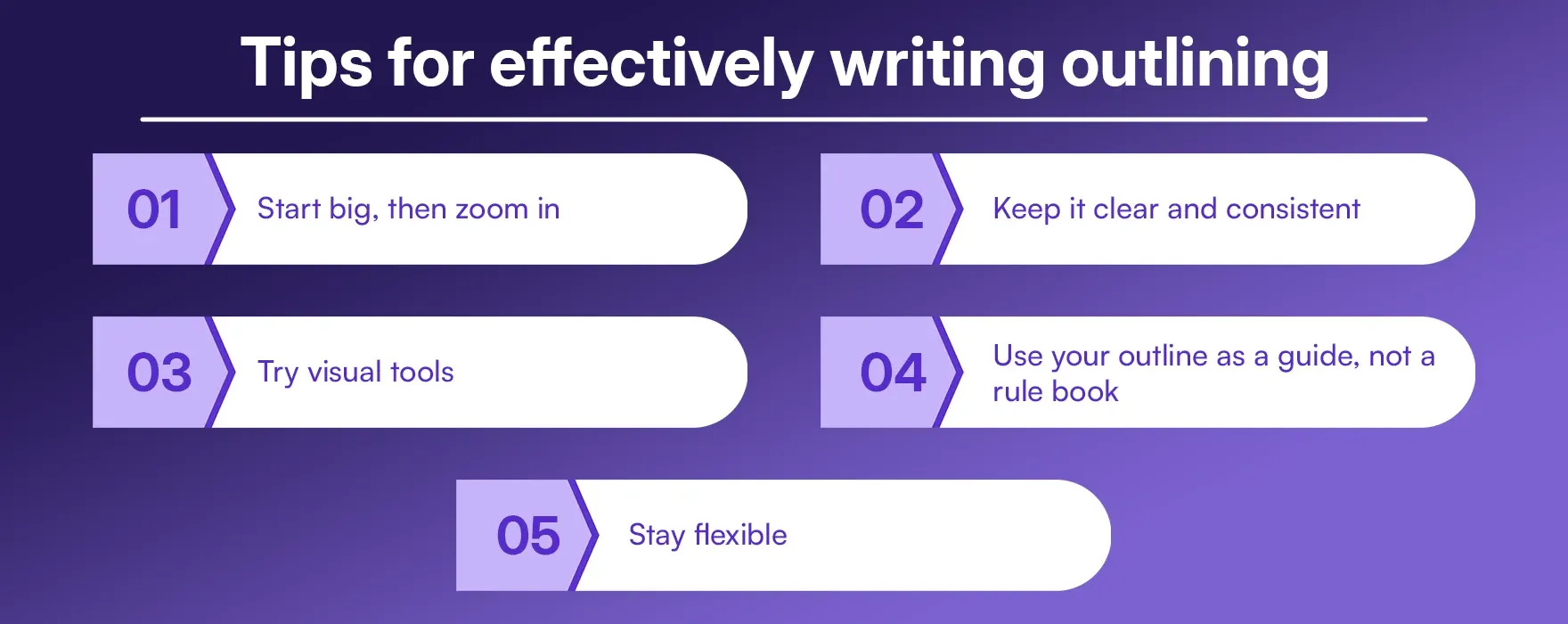
1. Start Big, Then Zoom In
Whenever you are outlining, you should always try to cover the important points of the content first so that the structure is maintained, and write smaller ideas as a sub-point or later. This is the basic rule of outlining: that you should always start with the major section, and after that, you should go into details and cover the points so that your main theme and flow are maintained.
How to apply it: You have to begin with a basic structure (like the classic intro-body-conclusion format). Once that's solid, add supporting points, examples, or research. For example, if you’re writing about healthy eating, start with broad sections like “Benefits of Healthy Eating” and “Common Challenges,” followed by any detailed topic like “Nutritional benefits of vegetables” or “Tips for meal planning.” Covering this maintains your important flow structure.
2. Keep it Clear and Consistent.
While outlining, always give yourself time to think and only after that do the outlining, because without outlining, your content will look quite messy to you, and overall, such an outline will also create difficulty for content writers to understand your theme and idea. That is why you should always keep your outline document in a parallel structure and consistent formatting so that your outline looks easy to read.
How to apply it: If you are also confused about how you can keep your outline clear and consistent, then let’s know this, too. If you’re listing subpoints, use the same grammatical structure. For example, instead of mixing “Improve focus” and “Better sleep quality is achieved,” use “Improve focus” and “Enhance sleep quality.” Also, keep your formatting consistent, don’t switch from bullets to numbers halfway through.
Use Your Outline as a Guide, Not a Rule Book
You should always use the outline to help you and give structure to your idea. Do not consider it as a rule book that you have to follow in every situation, We have given the basic idea of outline writing. Therefore, in final writing, if you get new ideas and if that idea can further improve the content, then you must give preference to it; never be rigid in the outline.
How to apply it: Think of your outline as a starting point. If you're writing and realise a section needs more depth or a new angle, update your outline to reflect that. For example, if you’re writing a blog post and you find a great statistic, add it to your outline under the relevant section.
Stay Flexible
As we already know that outlining is for keeping the work effective and in flow, this does not mean that you should not be flexible in your outline. Always try to add or remove points if you have a better idea or point. Such a flexible outline is also called a “living document,” so try to be flexible in your outline.
How to apply it: You always have to revisit your outline regularly. After a writing session, check if your outline still makes sense. Maybe you need to reorder sections, add new points, or cut something that’s not working. For example, if you’re writing a report and find a new case study, add a reference to it to your outline where it fits best.
Conclusion
We know a lot about outlining, and we know that outlining can give your deep ideas a clear structure and flow. And those outlines make writing the final content a lot easier, because you don’t have to think again and again what to write next, you have an outline as a map, and you just have to follow it.
Whether you’re using a formal alphanumeric outline for a research paper or a quick topic outline for a blog post, the key is to create a structured outline that keeps you focused while writing your ideas for creativity. By defining your central idea, mapping out major sections, choosing the right format, and adding supporting evidence, your outline is complete.
Just avoid common mistakes while outlining and try to write an outline better. In this, make your outline as flexible as possible and use creative visual tools like AssigningGPT AI in your outline, so that your outline becomes more effective.
FAQs
1. What is the format for an outline?
2. What are the three main parts of an outline?
3. How detailed should an outline be?
4. Can an outline be adjusted while writing?
Content writer at @AssignmentGPT
Ashu Singh, content writer at AssignmentGPT, crafting clear, engaging content that simplifies complex tech topics, with a focus on AI tools and digital platforms for empowered user experiences.
Master AI with
AssignmentGPT!
Get exclusive access to insider AI stories, tips and tricks. Sign up to the newsletter and be in the know!
Transform Your Studies with the Power of AssignmentGPT
Empower your academic pursuits with tools to enhance your learning speed and optimize your productivity, enabling you to excel in your studies with greater ease.
Start Your Free Trial ➤Start your success story with Assignment GPT! 🌟 Let's soar! 🚀
Step into the future of writing with our AI-powered platform. Start your free trial today and revolutionize your productivity, saving over 20 hours weekly.
Try For FREE ➤